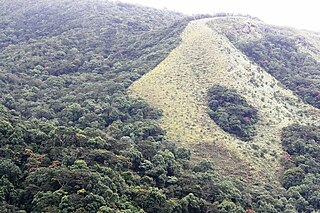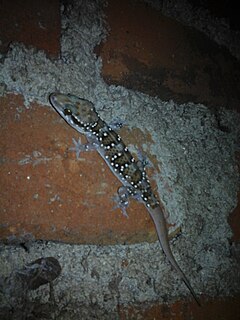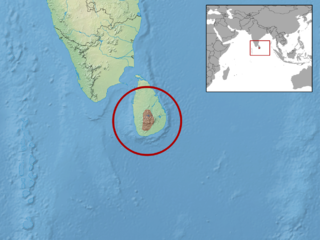
Poecilotheria is a genus of Asian tarantulas that was first described by Eugène Louis Simon in 1885. They are arboreal tarantulas, commonly known as ornamental tarantulas, known for their vivid color patterns, fast movement, and potent venom compared to other tarantulas. As of 2019 all species are protected under CITES.
Uperodon nagaoi, also known as the Nagao's pug-snout frog or Nagao's globular frog, is a species of frogs in the family Microhylidae. It is endemic to Sri Lanka and is known from the Central, Sabaragamuwa, Southern, and Western Provinces. The specific name nagaoi honours Eijiro Nagao, president of Marusan Securities who, through the Nagao Environmental Foundation, has supported research on Sri Lankan amphibians.
Wildlife of Sri Lanka includes its flora and fauna and their natural habitats. Sri Lanka has one of the highest rates of biological endemism in the world.
Hypnale walli, or Wall's hump-nosed viper, is a venomous pitviper species endemic to Sri Lanka. The smallest member of its genus, it is distinguished by having a strongly upturned nose and lower scale counts. No subspecies are currently recognized.

Hakgala Strict Nature Reserve is one of the three strict nature reserves in Sri Lanka, the only one in the wet zone. The reserve is an important although isolated cloud forest which supports a number of faunal species including some endemics. The area was designated a strict nature reserve on 25 February 1938. The reserve is adjacent to and contiguous with the Hakgala Botanical Garden which was founded in 1860.
Cophotis ceylanica is an agamid species endemic to Sri Lanka.
Cyrtodactylus fraenatus is a species of gecko endemic to the island of Sri Lanka.

Hemidactylus lankae is a species of gecko endemic to island of Sri Lanka.

Lankascincus taprobanensis, also known as the Ceylon tree skink, is a species of skink endemic to the island of Sri Lanka.

Poecilotheria smithi, or the yellow-backed ornamental, is a species of large arboreal tarantulas. It is endemic to Sri Lanka and considered to be critically endangered.
Belisana benjamini, is a species of spider of the genus Belisana. It is endemic to Sri Lanka.
Belisana keyti is a species of spider of the genus Belisana. It is endemic to Sri Lanka.
Belisana ratnapura is a species of spider of the genus Belisana. It is endemic to Sri Lanka.
Sihala ceylonicus, is a species of spider of the genus Sihala. It is known to be endemic to Sri Lanka, some suggest its presence in Malaysia as well.
Pholcus fragillimus, is a species of spider of the genus Pholcus. It is distributed from Sri Lanka, India to Japan. The type material of Pholcus fragillimus has probably been destroyed in Stuttgart during the Second World War, and only one female is available now in museums.
Tissahamia ethagala is a species of spider in the family Pholcidae. It is endemic to Sri Lanka.
Tissahamia maturata is a species of spider in the family Pholcidae. It is endemic to Sri Lanka.

Smeringopus pallidus, known as the pale daddy-long-leg, is a species of spider of the genus Smeringopus. It is a cosmopolitan species found in many countries.
Wanniyala agrabopath, is a species of spider of the genus Wanniyala. It is endemic to Sri Lanka. The species was described with a male found from Agrabopath Forest, Agrapatana, hence the specific name.
Wanniyala is a genus of cellar spiders native to Sri Lanka, first described by Huber & Benjamin in 2005. They have six eyes and four pair of legs and grow up to 2 mm in length. The abdomen is globular and males have a distinctive distal hinged sclerite on the procursus of genitalia. The name is derived from the Sri Lankans native to the island that the first spiders were found on- the Vedda people- and their surname Wanniyala-Aetto.





